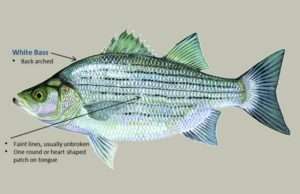 The state fish of Oklahoma is a fan favorite of springtime anglers. These prolific spawning fish make their annual migration runs in the thousands giving anglers the opportunity to catch fish in bulk. White bass require very basic fishing equipment making them an easy target for anglers of all experience levels!
The state fish of Oklahoma is a fan favorite of springtime anglers. These prolific spawning fish make their annual migration runs in the thousands giving anglers the opportunity to catch fish in bulk. White bass require very basic fishing equipment making them an easy target for anglers of all experience levels!
White bass typically start their spawning routine before the other warm water species in the state. Lifelong white bass anglers have long said that the white bass spawning run begins when the redbud trees begin to bloom.
White bass prefer to spawn up inflowing creeks and rivers on a given body of water. When water temperatures in the lake hit 50˚F, public access sites along those creeks and rivers are great places for those without a boat to target white bass.
For those with access to a boat, start your fishing efforts at the mouths of the inflowing tributaries and follow the white bass upstream. On a given body of water, the spawning run can last up to three weeks, but typically there’s a one week window when fishing is lights out. Local Game Wardens can usually provide the most up-to-date information on spawning white bass runs across the state.
WHITE BASS SPECIES PROFILE
Oklahoma Distribution
Although native to Oklahoma, white bass were not found in great numbers until large reservoirs were constructed. Now they are found statewide.
Description
The white bass can be identified by the distinctive arched back just behind its head. It also has only one tongue patch.
Habitat
These fish usually travel in large schools. Adults prefer open water over sandy shoals during the day and shallows at night.
Natural Food Sources
Shad, minnows, crustaceans and insects.
Spawning
White bass are very prolific. One female can produce up to one million eggs. Reproductive activities are triggered by water temperatures of 50 to 55 degree F. Spawning is at random over weeds, debris and rocks. When tributary streams are available, this species prefers upstream migration for spawning. No parental care is provided to eggs or young.
Facts
The white bass is Oklahoma’s state fish. An estimated one and a half million pounds of white bass are harvested annually from Oklahoma waters by sport fishermen. Due to their short life span and high reproductive capacity, no creel limits are imposed on some lakes. Anglers learn to watch for circling and diving gulls and/or surface disturbances as sure signs of schooling shad. Where there are shad, white bass are usually nearby.
WHITE BASS FISHING TIPS
When water temperatures get to the high 40s focus your efforts at the mouths of inflowing creeks and rivers on the north ends of the water body. Try lipless crankbaits in gold, silver or red patterns, sassy shad in pearl white, shallow- or medium-diving lipped crankbaits in shad-colored variations, and small white maribou jigs or curly tail grubs.
Each body of water in the state seems to have a bait of choice for white bass, so if you’re unfamiliar with the area bring an array of these types of lures until you find the one that picks up the most fish.
If fishing with artificial lures, keep your retrieve slow and steady.
You can also use a live minnow on a small- to medium-sized bait holding hook attached to a 12-inch leader line below a barrel swivel and ¼ to ½-ounce egg weight. Let the line off of the reel directly below the boat to your desired depth.
In lakes that do not have inflowing water, try the bait selections described above around coves, points and rip rap areas, especially during morning and evening hours.
When inflowing creeks and rivers are available, this species prefers upstream migration for spawning. No parental care is provided to eggs or young. Follow the fish upstream during the spawn and look for brushy areas along the bank or mouths of small tributaries to target.
White bass are a schooling fish, so if you’re not getting bites using these types of baits change locations often until you find them.
Fishing Setup
5’6 to 7′ medium light to medium action rod
4 to 10 pound monofilament line
Spinning, spincasting or casting reel
Popular Baits
1/8th to 1/4th ounce lipless crankbait in gold, silver or red
Curly tail white or chartreuse grub on a 1/16th to 1/4th ounce jighead
Shallow to medium diving lipped crankbait in a shad coloration
1/16th to 3/16th ounce white or chartreuse maribou jig
2-3″ sassy shad in pearl white or chartreuse on a 1/8th to 1/4 ounce jighead
Small to medium sized bait holding hook paired with a live minnow
Popular Spots
Tom Steed (SW)
Grand Lake watershed (NE)
Eufaula watershed (SE)
Lake Thunderbird (Central)
Canton watershed (NW)




